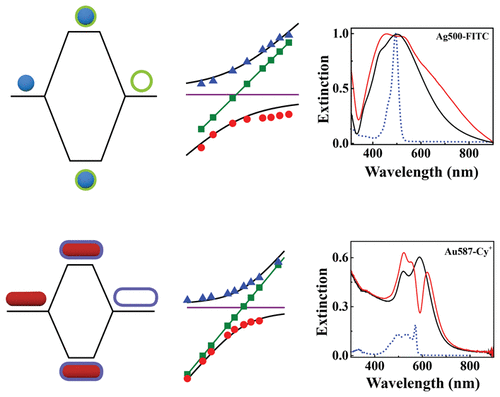Our official English website, www.x-mol.net, welcomes your feedback! (Note: you will need to create a separate account there.)
Plexcitons: The Role of Oscillator Strengths and Spectral Widths in Determining Strong Coupling
ACS Nano ( IF 17.1 ) Pub Date : 2018-01-05 00:00:00 , DOI: 10.1021/acsnano.7b06589 Reshmi Thomas 1 , Anoop Thomas 1 , Saranya Pullanchery 1 , Linta Joseph 1 , Sanoop Mambully Somasundaran 1 , Rotti Srinivasamurthy Swathi 1 , Stephen K. Gray 2 , K. George Thomas 1
ACS Nano ( IF 17.1 ) Pub Date : 2018-01-05 00:00:00 , DOI: 10.1021/acsnano.7b06589 Reshmi Thomas 1 , Anoop Thomas 1 , Saranya Pullanchery 1 , Linta Joseph 1 , Sanoop Mambully Somasundaran 1 , Rotti Srinivasamurthy Swathi 1 , Stephen K. Gray 2 , K. George Thomas 1
Affiliation

|
Strong coupling interactions between plasmon and exciton-based excitations have been proposed to be useful in the design of optoelectronic systems. However, the role of various optical parameters dictating the plasmon-exciton (plexciton) interactions is less understood. Herein, we propose an inequality for achieving strong coupling between plasmons and excitons through appropriate variation of their oscillator strengths and spectral widths. These aspects are found to be consistent with experiments on two sets of free-standing plexcitonic systems obtained by (i) linking fluorescein isothiocyanate on Ag nanoparticles of varying sizes through silane coupling and (ii) electrostatic binding of cyanine dyes on polystyrenesulfonate-coated Au nanorods of varying aspect ratios. Being covalently linked on Ag nanoparticles, fluorescein isothiocyanate remains in monomeric state, and its high oscillator strength and narrow spectral width enable us to approach the strong coupling limit. In contrast, in the presence of polystyrenesulfonate, monomeric forms of cyanine dyes exist in equilibrium with their aggregates: Coupling is not observed for monomers and H-aggregates whose optical parameters are unfavorable. The large aggregation number, narrow spectral width, and extremely high oscillator strength of J-aggregates of cyanines permit effective delocalization of excitons along the linear assembly of chromophores, which in turn leads to efficient coupling with the plasmons. Further, the results obtained from experiments and theoretical models are jointly employed to describe the plexcitonic states, estimate the coupling strengths, and rationalize the dispersion curves. The experimental results and the theoretical analysis presented here portray a way forward to the rational design of plexcitonic systems attaining the strong coupling limits.
中文翻译:

Plexcitons:振荡器强度和光谱宽度在确定强耦合中的作用
已经提出等离激元和基于激子的激发之间的强耦合相互作用在光电系统的设计中是有用的。但是,各种光学参数决定等离激子-激子(plexciton)相互作用的作用尚不甚了解。在此,我们提出了一个不等式,可以通过适当改变其振荡器强度和频谱宽度来实现等离激元和激子之间的强耦合。已发现这些方面与通过以下方式获得的两组独立的plexcitonic系统的实验一致:(i)通过硅烷偶联将荧光素异硫氰酸酯连接在各种尺寸的Ag纳米颗粒上,以及(ii)菁染料在聚苯乙烯磺酸盐涂覆的Au纳米棒上的静电结合不同的宽高比。在银纳米颗粒上共价连接 异硫氰酸荧光素保持单体状态,其高振荡器强度和窄光谱宽度使我们能够接近强耦合极限。相反,在聚苯乙烯磺酸盐的存在下,花青染料的单体形式与其聚集体平衡存在:对于光学参数不利的单体和H聚集体,未观察到偶联。菁的J聚集体具有大的聚集数,窄的光谱宽度和极高的振荡强度,可以使激子沿着生色团的线性组装有效地离域,进而导致与等离激元的有效耦合。此外,将从实验和理论模型获得的结果联合用于描述plexcitonic状态,估计耦合强度和合理化色散曲线。
更新日期:2018-01-05
中文翻译:

Plexcitons:振荡器强度和光谱宽度在确定强耦合中的作用
已经提出等离激元和基于激子的激发之间的强耦合相互作用在光电系统的设计中是有用的。但是,各种光学参数决定等离激子-激子(plexciton)相互作用的作用尚不甚了解。在此,我们提出了一个不等式,可以通过适当改变其振荡器强度和频谱宽度来实现等离激元和激子之间的强耦合。已发现这些方面与通过以下方式获得的两组独立的plexcitonic系统的实验一致:(i)通过硅烷偶联将荧光素异硫氰酸酯连接在各种尺寸的Ag纳米颗粒上,以及(ii)菁染料在聚苯乙烯磺酸盐涂覆的Au纳米棒上的静电结合不同的宽高比。在银纳米颗粒上共价连接 异硫氰酸荧光素保持单体状态,其高振荡器强度和窄光谱宽度使我们能够接近强耦合极限。相反,在聚苯乙烯磺酸盐的存在下,花青染料的单体形式与其聚集体平衡存在:对于光学参数不利的单体和H聚集体,未观察到偶联。菁的J聚集体具有大的聚集数,窄的光谱宽度和极高的振荡强度,可以使激子沿着生色团的线性组装有效地离域,进而导致与等离激元的有效耦合。此外,将从实验和理论模型获得的结果联合用于描述plexcitonic状态,估计耦合强度和合理化色散曲线。


























 京公网安备 11010802027423号
京公网安备 11010802027423号